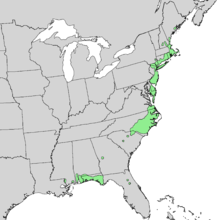
Back Chamaecyparis thyoides Bulgarian Chamaecyparis thyoides CEB Cypřišek zeravovitý Czech Hvid ædelcypres Danish Weiße Scheinzypresse German Chamaecyparis thyoides Spanish سرو سفید اطلسی Persian Céadar bán Irish Chamaecyparis thyoides Galician Գետնանոճի թույնման Armenian
| Chamaecyparis thyoides | |
|---|---|

| |
| Chamaecyparis thyoides near the edge of a bog in New Jersey | |
| Scientific classification | |
| Kingdom: | Plantae |
| Clade: | Tracheophytes |
| Clade: | Gymnospermae |
| Division: | Pinophyta |
| Class: | Pinopsida |
| Order: | Cupressales |
| Family: | Cupressaceae |
| Genus: | Chamaecyparis |
| Species: | C. thyoides
|
| Binomial name | |
| Chamaecyparis thyoides (L.) Britton, Sterns & Poggenb.
| |

| |
| Natural range of Chamaecyparis thyoides | |
Chamaecyparis thyoides (Atlantic white cedar, Atlantic white cypress, southern white cedar, whitecedar, or false-cypress), a species of Cupressaceae, is native to the Atlantic coast of North America and is found from southern Maine to Georgia and along the Gulf of Mexico coast from Florida to Mississippi. It is one of two species of Chamaecyparis found in North America. C. thyoides resides on the East Coast and C. lawsoniana can be found on the West Coast. There are two geographically isolated subspecies, treated by some botanists as distinct species, by others at just varietal rank: Chamaecyparis thyoides thyoides and Chamaecyparis thyoides henryae (H.L.Li) E.Murray (syn. Chamaecyparis thyoides subsp. henryae (H.L.Li) Little; Chamaecyparis henryae H.L.Li)[2][3][4] The species grows in forested wetlands where they tend to dominate the canopy. The trees are associated with a wide variety of other wetland species because of their wide north-south range. The remaining populations are now found mostly in remote locations that would be difficult to harvest, so its popularity as a source of lumber has decreased.
- ^ Farjon, A. (2013). "Chamaecyparis thyoides". IUCN Red List of Threatened Species. 2013: e.T42214A2962150. doi:10.2305/IUCN.UK.2013-1.RLTS.T42214A2962150.en. Retrieved 12 November 2021.
- ^ Cite error: The named reference
farjonwas invoked but never defined (see the help page). - ^ Cite error: The named reference
rushforthcwas invoked but never defined (see the help page). - ^ Mylecraine KA; et al. (2004). "Geographic allozyme variation in Atlantic white-cedar, Chamaecyparis thyoides (Cupresseceae)". Canadian Journal of Forest Research. 34 (12): 2443–2454. doi:10.1139/X04-125.
